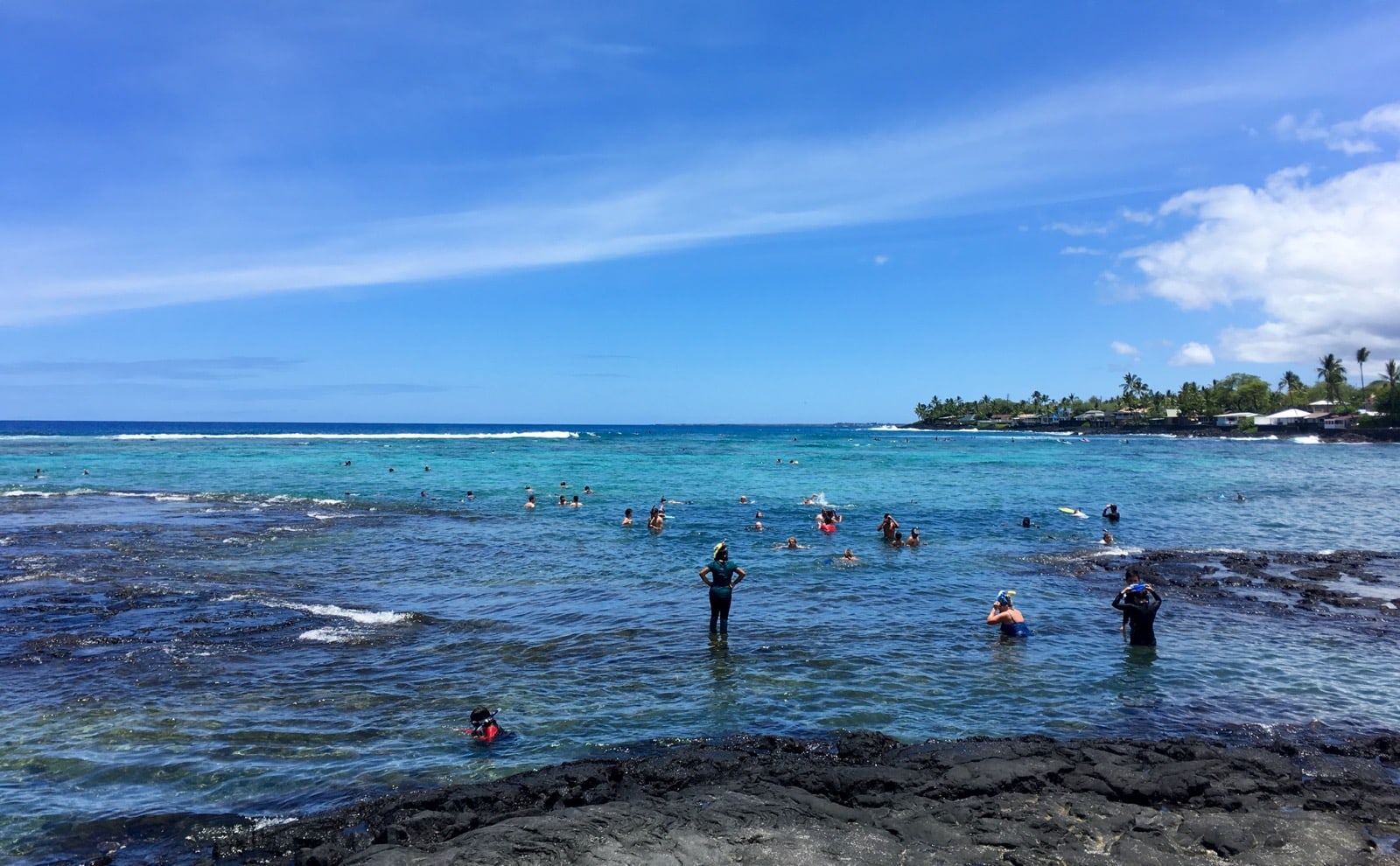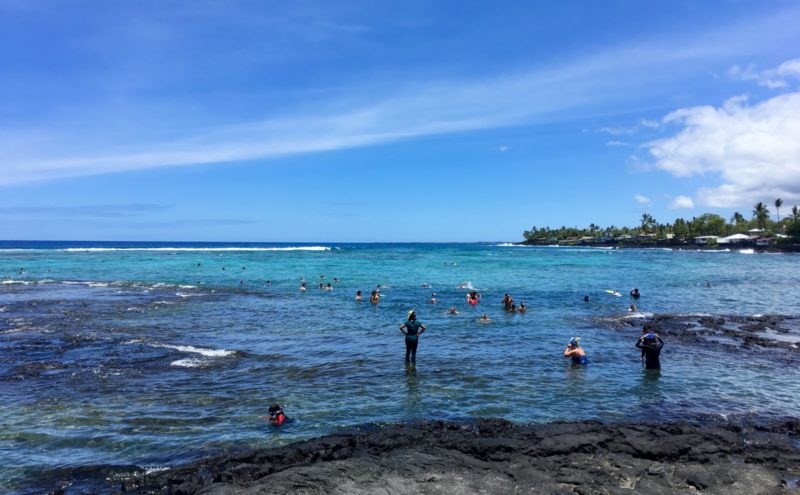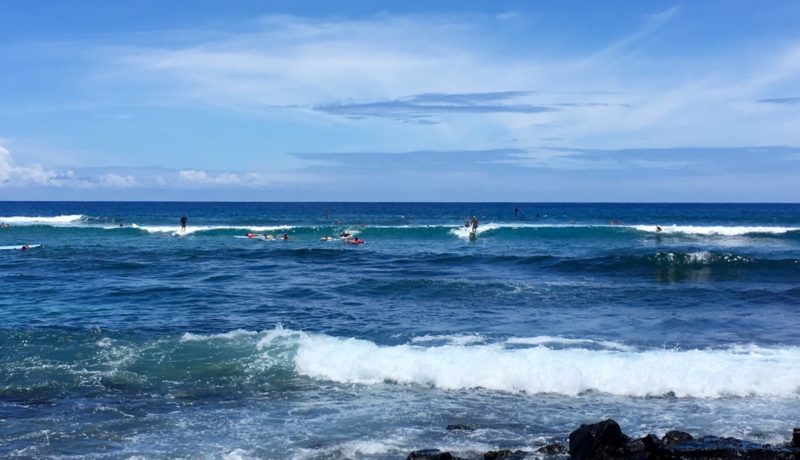Welcome to a real life aquarium! Kahaluʻu is a wide protected bay on the Kona coast just a few miles south of Kailua-Kona town center and offers some of the island’s best and most easily accessible snorkeling. Beneath the surface of Kahaluʻu Bay’s crystal clear, brilliant blue waters, you will come face to face with sea turtles, coral heads, and a variety of brightly colored tropical fish.
Use the table of contents to skip ahead to the following sections about Kahaluʻu beach park:
Table of contents
- Introduction
- Snorkeling: gear rental, safety tips, and best snorkeling spots
- Surfing: gear rental, surf classes and surf tips
- Beach facilities and directions
Table of Contents
- Introduction
- Snorkeling: gear rental, safety tips, and best snorkeling spots
- Surfing: gear rental, surf classes and surf tips
- Beach facilities and directions
More snorkeling information
You can find more information on all local snorkeling and surfing spots in our “Big Island snorkeling” and “Big Island surfing” guides.
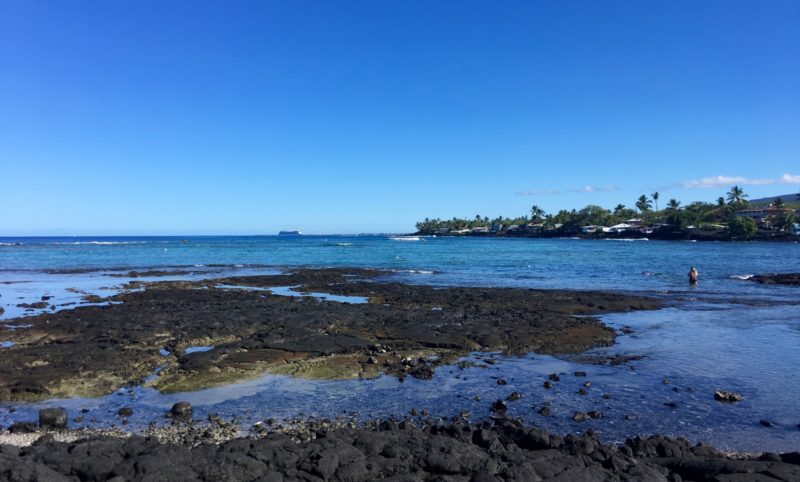
Kahaluʻu bay is protected from high surf by a small reef and is one of the best places for snorkeling on the Big Island.
Kahaluʻu Beach Park in a nutshell
Listed on the National Register of Historical Places, Kahalu’u Bay has significant Hawaiian cultural history. The bay has been populated for at least the last 500 years with records of royal residences in the 18th and 19th centuries and several heiaus (Hawaiian temples) in the area. The heiau on the northern side of Kahalu’u Bay, Kuʻemanu Heiau, overlooks a surf break – popular in ancient times and still to this day.
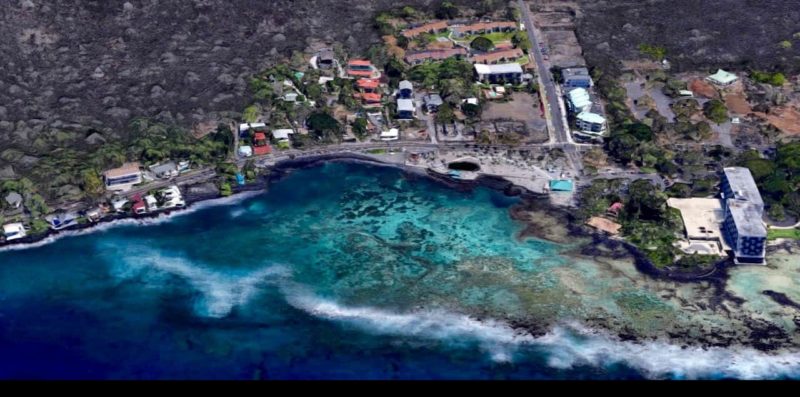
Birds eye view of Kahaluʻu beach park, close to Kona just off Aliʻi drive. Image credit: google maps
While you can go to this beach for sunbathing the main attractions here are the snorkeling and the surfing which we describe below.
Snorkeling at Kahaluʻu Bay
Kahaluʻu bay is a great snorkeling beach. It is one of our 3 favorite snorkeling spots on the whole island and one of our favorite snorkeling spots for beginners of the whole state!
The reef at Kahaluʻu Bay is a living, breathing ecosystem home to numerous aquatic creatures. The foundation of this habitat is the coral reef. As you venture beneath the surface, keep your eyes peeled for sea turtles, octopus, sea urchins, eels, and dozens of fish species including Yellow Tang, Bullethead Parrotfish, Racoon Butterflyfish, Moorish Idol, Orangespine Unicornfish, Hawaiian Spotted Boxfish, and more.
You can have a small preview of some of the residents of Kahaluʻu Bay, the fish, honu, and invertebrates that play a critical role in maintaining the delicate balance of this reef ecosystem, in the short video below:
The best place for snorkeling, and where to get in the water
Depending on the tide and ocean conditions, getting in the water at Kahaluʻu can be (sometimes) challenging. The channel in front of the lifeguard tower is the best place to get in the water to snorkel. You’ll need to navigate over some lava rock, which can be slippery and tough on your feet so some snorkelers choose to wear water shoes, neoprene surf socks, or tabis (a local style water slipper) to protect their feet.
To make entering the water easier, wait to put on your mask, snorkel, and fins and carry them in one hand, leaving the other hand free to prevent a fall as you walk slowly over the rocky entrance area. On the other side of the rocks is a sandy bottom area that is shallow enough to stand in and put on your snorkeling gear. When exiting the water, use this same pathway.
See the following 90 second video to see more tips on where and how to enter Kahaluʻu Bay safely.
If you are a decent swimmer, head toward the middle of Kahaluʻu Bay where some of the larger coral heads can be found. Go slowly as you swim over the coral heads, or simply stop and float. This will give you a chance to spot some of the shy critters living inside. You will see a second lifeguard tower as you approach the center of the bay. Don’t go beyond this tower, as you will be entering into the surf zone.
Snorkel gear rental @ Kahaluʻu Bay
If you have not yet rented (or brought!) snorkel equipment you can do so just across the road from Kahaluʻu Bay at Kahaluʻu Surf and Sea.
Safety tips
There is a current in Kahaluʻu Bay that flows north and out to sea. Usually, it’s mild in the snorkeling area, however, it can pick up with big swell. As you snorkel, periodically lift your head above water to check your surroundings and adjust your position.
Always pay attention to lifeguard’s announcements about surf conditions. If you are in distress, raising one hand above your head is a signal for help which the lifeguards will understand. If lifeguards are not on duty, call 911 in an emergency and give your location as Kahaluʻu Beach Park snorkel beach.
Please respect the reef!
The ocean life in Kahaluʻu bay is already suffering under the popularity of the beach so please be mindful of the following tips that help preserve the corals.
- Coral is alive and touching or stepping on coral can damage or kill it. When snorkeling, do not chase or touch any living creatures, including the coral with your body or fins. While the water is relatively shallow, do not put your feet down or walk on the reef.
- Another way you can help protect the reef is to use reef-safe sunscreen. Most major sunscreen brands contain chemicals that are known to cause coral bleaching and are harmful to the reef. Reef-safe sunscreens are made with the active ingredients Zinc oxide or Titanium dioxide. As of 2021 two new reef-safe sunscreen dispensers have been installed at the pavilion, please use those if you didn’t bring reef-safe sunscreen yourself. For a list of reef-safe sunscreen brands and local retailers where they can be purchased, visit the Kahaluʻu Bay Education Center website.
Surfing at Kahaluʻu bay
Since ancient times, the northern end of Kahaluʻu Bay has been a special place for surfing. The stunning, crystal clear water makes it possible to view the reef beneath your board. Kuʻemanu Heiau, which overlooks the break, was used to pray for good surfing conditions and to observe surfers.
Today, surfers still love catching waves at Kahaluʻu Bay due to its ease of access to the water, its favorable wind and swell conditions, and its natural beauty. Waves break and reform on the reef, offering smaller waves for beginners. When there’s swell, waves breaking on the outside can reach decent height of 4-6 feet or more for advanced surfers. The break is primarily a right hand break, but it is possible to catch some lefts on the far north end.
Surf Lessons & Surfboard Rentals
If you’re interested in learning to surf, Kahaluʻu Bay is an excellent place for a lesson. Several different surf schools operate out of the bay but the one operating here for the longest is Kahaluʻu Surf and Sea (see below). They are the place to go for classes and board rentals:
Surf Lessons in Kona
Learn to surf with a small group 2-hour session. Friendly and professional surf instructors will have you riding the waves in just minutes, with lessons matched to your skill level
from:
$139
What is a suggested tour?Our suggested tours are hand-picked tours that receive consistent good reviews, give back to the community, and work hard to minimize their impact on the environment. Read more about these tours on our website.If you don’t want to rent your gear at the bay you can for example visit Miller’s Surf (located in downtown Kailua-Kona) for surfboard and boogie board rentals.
Safety tips
The current at Kahaluʻu Bay can be quite strong in the surfing area, especially when there is big surf. The current pulls you north and out to sea. When surfing at Kahaluʻu Bay, be sure to pick out landmarks on shore and periodically check your alignment with them. Those who are not experienced surfers are advised to stay on the inside, and not paddle out to the outside break, especially in high surf conditions.
Take care entering and exiting the water. The common entrance point for surfing the bay is next to the little blue church, Saint Peters by the Sea, which dates to 1880. This entrance point served as an ancient canoe landing site, and provides a relatively flat rock surface to gradually ease into the water. Take your time and walk slowly as the rocks can be slippery. Once out in the bay, avoid touching your feet to the reef, as it can damage the corals and/or cut you.
Surfing etiquette
Please be respectful of locals who surf at Kahaluʻu everyday. A simple friendly good morning can go a long way. Be courteous and take turns on waves. Never ‘drop in’ on a wave another surfer is already riding, or cut them off. Always keep a firm hold on your board, so you don’t hit another surfer with it.
Kahaluʻu Beach Park Facilities
For surfers, bathrooms and an outdoor shower are located next door to the surfing area on the other side of the small black sand beach and lifeguard stand. There are some picnic tables on this side of the bay with a good view of the surf break.
For snorkelers, bathrooms and outdoor showers are located right next to the snorkeling beach and first lifeguard tower. There is a large covered picnic pavilion with a BBQ adjacent to the bathrooms which can be rented for special events. Additional picnic tables and BBQs are available on the far side of the beach in a palm grove.
Getting to the Kahaluʻu Beach Park
Kahaluʻu Bay is about 5 miles south of Kailua-Kona town center. Most people access it by car, but it can also be reached by the Kona Trolley, by bike, or simply by walking along scenic Aliʻi Drive, depending on how far away you are staying.
You can find the current ocean conditions at the Kahaluʻu beach park on the Hawaii Beach Safety website.
Parking
Nonresident visitors are asked to pay a small parking fee in four-hour intervals from 7 a.m. to 7 p.m. daily. All net income from the parking fees will be used solely for the benefit of the maintenance, enhancement and protection of Kahaluʻu Bay’s natural resources. Hawai’i residents and disabled individuals will register with the attendant on duty for a free parking pass.
- For snorkeling, the best place to park is in the parking lot on the south side of the bay, next to the bathrooms.
- For surfing, parking is generally along the Ma Kai (ocean) side of the road on the northern end of the bay. Overflow parking on busy days can be found up Makolea St. directly across from the parking lot entrance, or along the Ma Uka (mountain) side of the road.
